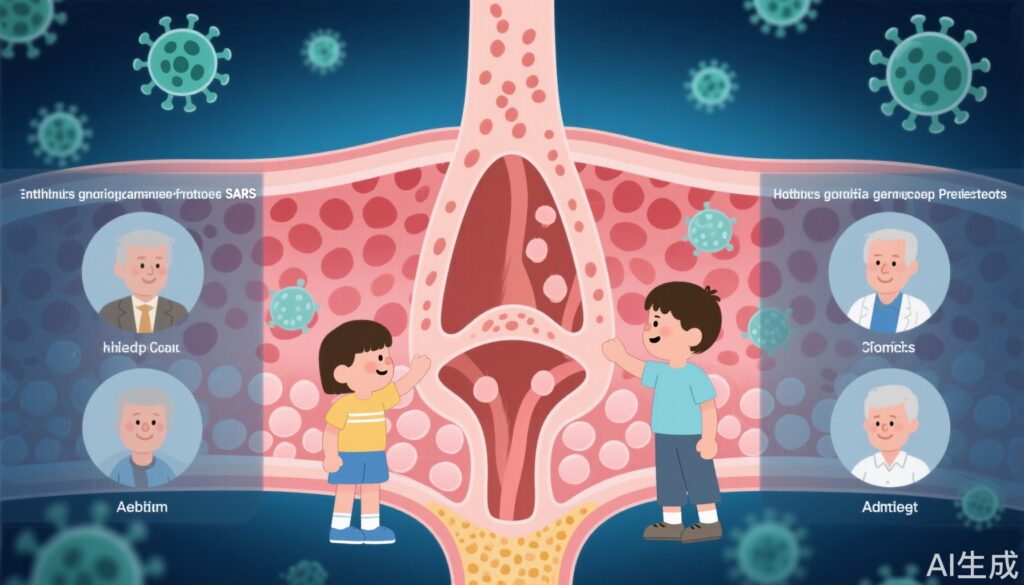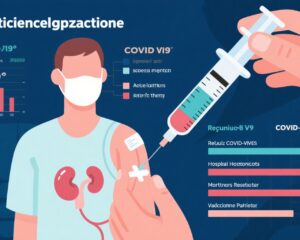Highlights
- Prior rhinovirus infection is associated with a 48% reduction in subsequent COVID-19 risk.
- Recent rhinovirus infection correlates with a nearly 10-fold lower SARS-CoV-2 viral load in infected individuals.
- Increased expression of antiviral airway genes, induced by rhinovirus, underpins this protection.
- Children, having higher rates of rhinovirus infection and antiviral gene expression, may experience milder SARS-CoV-2 infection.
Background
The coronavirus disease 2019 (COVID-19), caused by SARS-CoV-2, has had a global health impact since its emergence. Children typically manifest milder COVID-19 symptoms compared to adults, a paradox given their susceptibility to other viral respiratory infections. Understanding potential protective factors, such as prior common cold infections caused by rhinoviruses, could illuminate mechanisms of natural antiviral defense and guide public health strategies.
Key Content
Study Design and Population
This investigation leveraged the Human Epidemiology and Response to SARS-CoV-2 (HEROS) cohort, encompassing 1,156 US children and adults, monitored via 10,493 repeat nasal swabs from May 2020 to February 2021. The cohort was tested for 21 respiratory pathogens, focusing on the interplay between rhinovirus infections and SARS-CoV-2 risk.
Rhinovirus Infection and SARS-CoV-2 Risk Reduction
Participants with documented rhinovirus infection within 30 days before SARS-CoV-2 exposure demonstrated a 48% lower risk of COVID-19 (adjusted hazard ratio [aHR], 0.52). This protective association was confirmed via sensitivity analyses, indicating that recent and symptomatic rhinovirus infections conferred greater risk reductions than distant or asymptomatic infections.
Impact on Viral Load and Severity
Among participants infected with SARS-CoV-2, recent rhinovirus infection was linked to a striking 9.6-fold reduction in SARS-CoV-2 viral load, a proxy for infection severity and transmissibility. This finding provides mechanistic insight into how prior common cold may attenuate COVID-19 severity.
Antiviral Gene Expression and Age Differences
RNA sequencing of nasal swabs identified 57 genes whose higher pre-infection expression correlated with lower SARS-CoV-2 viral loads. Notably, 24 of these genes were antiviral defense genes, with 22 upregulated by rhinovirus infection. Children exhibited higher baseline expression of this antiviral gene signature and were 2.2 times more likely to have rhinovirus infections than adults. These data suggest frequent rhinovirus exposures in children may prime innate antiviral defenses, mitigating SARS-CoV-2 infection severity.
Comparative Mechanistic Insights
These findings align with broader viral interference concepts, where prior viral infections induce a heightened antiviral state through interferon-stimulated genes and innate immune activation, reducing susceptibility to subsequent viral pathogens. This study extends such concepts specifically to common cold rhinovirus and COVID-19.
Expert Commentary
The HEROS cohort analysis robustly implicates prior rhinovirus infections in conferring partial protection against COVID-19. This is supported by advanced molecular profiling revealing antiviral gene induction pathways. The study’s prospective design and repeated pathogen testing strengthen causal inference. However, residual confounding, differences in exposure risk, and potential behavioral factors warrant consideration.
Clinically, these results provide a plausible biological explanation for the observed age-related differences in COVID-19 severity, emphasizing the role of innate immune memory and cross-viral protection. The identification of specific antiviral signatures may inspire therapeutic targeting or prophylactic strategies harnessing innate immunity.
Moreover, these observations underscore the complexity of viral co-infections and their temporal dynamics in respiratory tract infections. Further exploration of viral interference in diverse populations and variants of concern remains essential.
Conclusion
Recent rhinovirus infection substantially reduces the risk and severity of subsequent SARS-CoV-2 infection, mediated by enhanced expression of antiviral airway genes. These findings may explain why children generally experience milder COVID-19 compared to adults, given their higher frequency of common colds and elevated antiviral gene activity. The study advances understanding of innate antiviral defenses and suggests that recurrent common cold exposures modulate susceptibility to novel respiratory viruses such as SARS-CoV-2. Future research should investigate how these mechanisms inform preventive measures in respiratory viral pandemics.
References
- Moore CM, Secor EA, Everman JL, et al. The common cold is associated with protection from SARS-CoV-2 infections. J Infect Dis. 2025 Aug 11:jiaf374. doi:10.1093/infdis/jiaf374. Epub ahead of print. PMID: 40795882.


